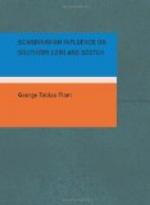PART II.
A List of Scandinavian Loanwords taken chiefly from
“The Bruce,”
“The Wallace,” Wyntoun’s
Chronicle, Dunbar, Douglas, Lyndsay,
Alexander Scott, Montgomery, Ramsay and
Burns.
PART III.
1. The Dialectal Provenience of Loanwords.
2. (a) The Old Northern Vowels in the Loanwords.
Short Vowels, Long
Vowels, Diphthongs.
(b) The Old Northern Consonants.
* * * * *
PART I.
INTRODUCTION.
1. GENERAL REMARKS.
Worsaae’s list of 1400 place-names in England gives us an idea of the extent, as well as the distribution of Scandinavian settlements in the 9th and 10th centuries. How long Scandinavian was spoken in England we do not know, but it is probable that it began to merge into English at an early date. The result was a language largely mixed with Norse and Danish elements. These are especially prominent in the M.E. works “Ormulum,” “Cursor Mundi,” and “Havelok.” We have historical records of the Danes in Central and Eastern England. We have no such records of Scandinavian settlements in Northwestern England, but that they took place on an extensive scale 300 place-names in Cumberland and Westmoreland prove. In Southern Scotland, there are only about 100 Scandinavian place-names, which would indicate that such settlements here were on a far smaller scale than in Yorkshire, Lincolnshire, or Cumberland—which inference, however, the large number of Scandinavian elements in Early Scotch seems to disprove. I have attempted to ascertain how extensive these elements are in the literature of Scotland. It is possible that the settlements were more numerous than place-names indicate, that they took place at a later date, for instance, than those in Central England. Brate showed that the general character of Scandinavian loanwords in the Ormulum is East Scandinavian. Wall concludes that it is not possible to determine the exact source of the loanwords in modern English dialects because “the dialect spoken by the Norsemen and the Danes at the time of settlement had not become sufficiently differentiated to leave any distinctive trace in the loanwords borrowed from them, or (that) neither race preponderated in any district so far as to leave any distinctive mark upon the dialect of the English peasantry.” It is true that the general character of the language of the two races was at the time very much the same, but some very definite dialectal differentiations had already taken place, and I believe the dialectal provenience of a very large number of the loanwords can be determined. Furthermore, the distribution of certain place-names indicates that certain parts were settled more especially by Danes, others by Norsemen. The larger number of loanwords in Wall’s “List A” seem to me to be Danish. My own list of loanwords bears a distinctively Norse stamp, as I shall show in Part III. of this work. This we should also expect, judging from the general character of Scandinavian place-names in Southern Scotland.




